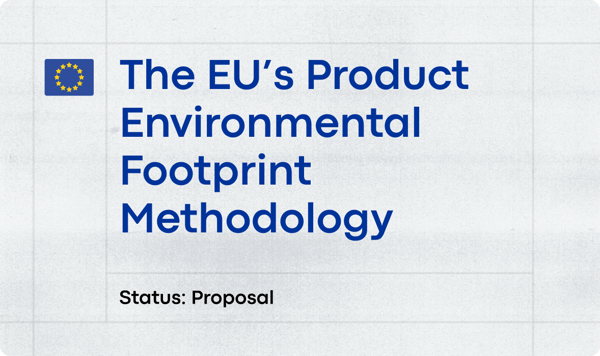"You Ask, We Answer" – brought to you by Carbonfact's Head of Science. Each week Laurent Vandepaer answers one of your questions about sustainable materials, manufacturing impact, and energy transition in the apparel and footwear industry.
Before joining Carbonfact, Laurent led the integration of LCA into the sustainability and innovation efforts at On and performed LCA for other brands like Arc'teryx. Laurent also worked for several years in research with a PhD focusing on the deployment of LCA at a large scale.
Question: Packaging - What is better in terms of carbon emissions: recycled paper/cardboard or recycled plastic? What is better between paper / cardboard recycled or not recycled?
I'm asking because we find contradictory information on that depending on the secondary dataset used
Asked by the Head of Sustainability from a fashion brand
Answer
Recycled paper and cardboard generally have lower carbon emissions compared to recycled plastic, due to less energy-intensive recycling processes and the absence of fossil fuel inputs. Recycled paper or cardboard is better than using virgin one.
Variations in emission factors reported by different databases such as ADEME, DEFRA, and Ecoinvent can be attributed to factors like the technological methods used (mechanical versus chemical recycling), the quality of the recycling process (open-loop versus closed-loop), and geographical differences in recycling practice.
When comparing the carbon impact of recycled plastic with paper packaging you should also consider the following aspects:
- Function: Comparability of plastic, paper, and cardboard, as they usually serve different packaging functions.
- Weight: Different weights/densities and lifespans of the materials. For instance, plastic might be lighter and more durable, while paper and cardboard are typically heavier and have shorter lifespans.
- Recycling rates: Paper and cardboard benefit from curbside recycling streams and generally have much higher recycling rates compared to plastics. This established infrastructure can significantly affect the environmental benefits of using recycled paper and cardboard.
- Microplastic shedding: An important concern with plastic packaging is the shedding of microplastics, which can have harmful environmental and health effects.
Here are the details:
Variability when comparing emission factors from different databases
There is always variability when comparing emission factors from different sources, which can make the results counterintuitive and emission factors not always comparable. This applies to both virgin and recycled materials, and the variability in the results can be explained by:
- Differences in the technology used (e.g., LDPE can be recycled mechanically or chemically)
- Geographical variations (e.g., recycling paper in France differs from recycling in Asia)
- Methodological differences (e.g., cut-off vs. CFF, varying background LCI database)
- Temporal changes (e.g., a recycling process today versus one 20 years ago).
Let’s dive deeper into some additional references and details to help you make sense of the varying numbers.
Recycled plastics (LDPE) carbon footprint
We find emission factors ranging from 2.626 kg CO2e/t (EF 3.1) to 202 kg CO2e/t (ADEME Base Empreinte) to 1793 kg CO2e/t (DEFRA). Given the significant differences in data sources and methodologies, it is advisable to disregard the Base Empreinte reference for evaluating carbon emissions of recycled materials.
The spread between the DEFRA and EF3.1 impact scores shows the possible range of impacts. You just need to clarify whether your source represents closed-loop/chemical recycling or a simpler mechanical process.
The details:
- ADEME Base Empreinte Database: The emission factor for recycled LDPE is 202 kg CO2e/t.
What could explain this number?
→ The original source is data collected in 2003 and reported in 2006. At that time, the representation of the technosphere (the human-made environment) was less comprehensive. Fewer processes and flows were considered, often leading to smaller reported impacts.
→ It also represents an open-loop recycling process, where recycled materials are turned into different products, often of lower quality and functionality than the original material (downcycling). In open-loop recycling, less effort is made to maintain the quality of materials, resulting in lower energy consumption and input requirements. This leads to a lower overall carbon footprint for the recycled material but also shorter subsequent lifespans, bringing the material closer to landfill and incineration compared to a closed-loop alternative.
- DEFRA Database: The emission factor for LDPE is 1793 kg CO2e/t, reflecting more recent data and closed-loop recycling processes. The emission factor from DEFRA is based on more recent data and reflects current, more comprehensive environmental accounting practices.
Closed-Loop Recycling: It represents a closed-loop recycling process. The closed-loop approach aims to maintain the quality and functionality of the original material, allowing it to be reused in similar applications. In the file, it is defined as, “The materials are made from recycled content where the previous product was the same as the new product.” This process often requires more energy and sophisticated technology to ensure the recycled material retains its original properties, likely corresponding to a chemical recycling process. Consequently, the energy consumption and inputs are higher, resulting in a higher carbon footprint.
- EF3.1 Data: Low-density polyethylene (LDPE), recycled: 824 kg CO2e/t and low-density polyethylene (LDPE), fossil fuel-based: 2.626 kg CO2e/t. The recycled material is also mechanically processed through an open-loop setup, explaining the lower score.
Recycled and virgin paper and cardboard carbon footprint
Cardboard
- ADEME Base Empreinte Database: The emission factor for recycled cardboard is higher (670 kg CO2/t) than for virgin cardboard (390 kg CO2/t).
- DEFRA Database: The emission factor for virgin cardboard is 801 kg CO2e/t, and for recycled cardboard, it is 700 kg CO2e/t.
Paper
- ADEME Base Empreinte Database: the emission factor of paper is archived and is the same for recycled (Papier/recyclé) and virgin paper (Papier/neuf) 1320kgCO2/t
- DEFRA Database: The emission factor for virgin paper is 910 kg CO2/t, and for recycled paper, it is 730 kg CO2/t.
- Ecoinvent: While we may not publish specific emission factors from this database, a qualitative comparison of the data from Ecoinvent reveals important insights:
- In the Ecoinvent database, the carbon emissions associated with recycled paper production tend to be lower than those of virgin paper. For instance, the production of newsprint from recycled paper shows a reduced carbon footprint compared to its virgin counterpart.
- Similarly, producing woodfree, uncoated paper with 100% recycled content results in lower emissions than using virgin materials.
- For corrugated board box production, the dataset reflects an average of recycled and virgin paper inputs across Europe. This mixed approach highlights the varying impacts based on the proportion of recycled content used.
Geographical Variability
It is important to keep in mind that there can be significant variability in climate impacts across countries, which might explain the variations you have noticed. This paper shows it well:
- for recycled graphic paper 0.36 to 2.25 kg CO2-Eq/kg wastepaper recycled,
- newsprint (0.27 to 1.84 kg CO2-Eq/kg wastepaper recycled) and corrugated
- cardboard (0.28 to 1.68 kg CO2-Eq/kg wastepaper recycled) productions.
Same here: see table below (primary is virgin, secondary is recycled). In this case, in addition to geography, there are also technological and methodological variations in the reviewed references.
About Carbonfact
Carbonfact is Sustainability software, built specifically for apparel and footwear brands as well as manufacturers to measure the environmental impact of their products and take actionable steps to reduce their footprint. Our Product Impact Simulation tool enables you to run what-if scenarios on a product level, where you can experiment with different packaging materials, suppliers, renewable electricity share, or transportation methods, and build concrete company-level decarbonization scenarios.
Do you have questions about sustainable practices, manufacturing impacts, or energy transitions in the apparel and footwear industry? We'd love to hear from you! Send us a DM on Linkedin or email: youaskweanswer@carbonfact.com







 Lidia Lüttin
Lidia Lüttin

![[Guide] Carbon accounting for fashion, textile, apparel, and footwear companies](https://www.carbonfact.com/hs-fs/hubfs/CA%20-%20Opt1.png?width=600&name=CA%20-%20Opt1.png)
 Angie Wu
Angie Wu